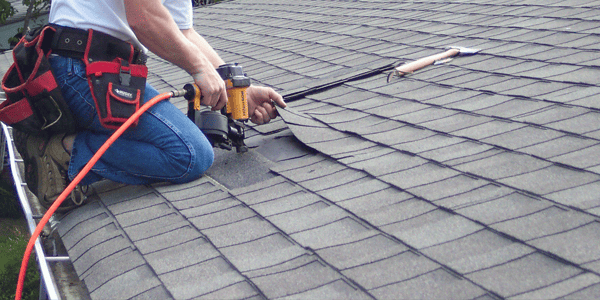So, a storm caused damage to your roof. Or, a tree branch fell and punctured your shingles. You’re probably thinking, “Why should I have to pay for this?”
Well, you’re right! You shouldn’t have to pay for home damage that wasn’t your fault. That’s exactly why homeowners insurance exists. If your roof sustained damage from outside forces, there’s a good chance your insurance company will provide some amount of coverage.
While no one can guarantee that you’ll receive insurance coverage, it can often be worth it to file a claim to find out. To learn how to get insurance to pay for a roof replacement, follow the seven easy steps below!
Step 1: Call a Trusted Roofer
The first thing you should do right after a significant storm is to call a local, highly-rated roofing company. Even if you don’t see visible damage from the ground, it’s worth it to schedule an inspection to learn if there’s any hidden damage. Many professional roofing companies offer free inspections and estimates to help you get started.
Sometimes, big storms can attract “storm chasers.” These unlicensed and uninsured “contractors” often show up at your doorstep and make lofty claims or demand cash upfront. However, many reputable roofers also go around neighborhoods and leave information about their services.

To ensure you’re working with a contractor you can trust, follow these tips:
- Ask the contractor about their licensure and insurance. ✅
- Read online reviews and pursue their website. (If they have poor reviews or don’t have an online presence at all, that’s a red flag.) ✅
- Ask the contractor to describe their inspection process and how they’ll work with your insurance. ✅
- Ensure they have a local address and/or phone number. ✅
If you feel confident that you’re talking to a locally-trusted roofer, schedule a time for a roof inspection as soon as possible.
Step 2: Review Your Insurance Policy
It may take a day or two for your roofing contractor to get to your property for an inspection. If the storm was significant and affected many homes, the wait time might be a little longer.
In the meantime, review your insurance policy. You want to make sure that your roof damage is covered by your policy so that you don’t waste any time filing a claim unnecessarily. Typically, common types of roof storm damage are covered by standard homeowners insurance policies, including damage from:
- Hail 🧊
- Wind 🌬️
- Flying debris 🌳
- Fire 🔥
- Vandalism 🥷
If your damage was caused by a lack of maintenance or homeowner neglect, you likely won’t get any insurance coverage.
Step 3: Get a Roof Inspection
When your scheduled service date arrives, your roofing contractor will perform a detailed roof inspection. Sometimes, they’ll also check out your attic. These inspections should be thorough and last 30-60 minutes, depending on the size of your roof. If your contractor is in and out in 10 minutes, you should get a second opinion.
A good roofer will take photos of any storm damage on your roof. Then, they’ll write up a detailed report that outlines your damage, the suggested service, and how much that service will cost. Sometimes, you may have enough damage to warrant a total roof replacement. Other times, minor damage may only constitute repairs.
Step 4: File a Claim

Next, it’s time to actually file the insurance claim. You’ll need to get in touch with your insurance agent either by phone or online. Claims can usually be filed online, but you may need to send documents in the mail.
Any evidence of damage goes a long way in insurance claims. You can use the photos and written report from your roofing contractor to support your claim.
- Note: Be sure to act fast after a storm. The longer you wait to file a claim, the less likely it is that you’ll get approved. Many insurance companies only accept claims within one year of the damaging event.
Step 5: Schedule an Appointment With an Adjuster
Your insurer can’t approve your claim on the spot. They’ll send an insurance adjuster to your home to inspect the roof themselves.
Schedule a time for the adjuster to come to your property, and, if possible, coordinate it so that your roofing contractor can also be present. Having your contractor there will ensure your adjuster doesn’t miss or mistake any storm damage.
Step 6: Schedule Roofing Service
After the adjuster inspects your roof, they will either approve or deny your claim. If your claim is approved, they’ll provide coverage for the necessary services. Keep in mind that you’ll need to pay your deductible if you haven’t already, so that amount will be subtracted from your coverage.
Once you receive the green light from insurance, you can go ahead and schedule your roof replacement with your preferred roofing company. You are always allowed to choose the contractor you want— you’re not required to work with someone recommended by your insurance company.
Step 7: Enjoy Your New Roof!
Your roofing contractor will schedule your roof replacement for as soon as they’re able. This timeline will depend on how quickly the materials can arrive and how backed up the contractor is. As we mentioned earlier, if there was a major storm in your area, many roofing contractors will likely be very busy.
Insurance companies often pay the contractor directly, but they may send you a coverage check in the mail. You can then use those funds to pay your contractor.
When all the work is said and done and all the nails are cleaned up from your yard, you can sit back, relax, and enjoy your beautiful new roof.
Work With Tidds for Your Storm Damage Claim
We hope this guide helps you feel more confident about the roof insurance claim process. If you live in North Carolina, you can depend on Tidds Roofing to guide you through the process every step of the way. With over 15 years of experience, we’ve helped hundreds of homeowners just like you through the same situations.
Get in touch today to schedule your free inspection!



